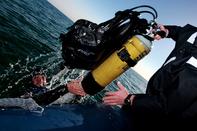Aliwal Shoal
With this dive site now being classed as a Marine Protected Area, permits are necessary to dive on the Aliwal Shoal. These permits can be obtained at your nearest post office or at some dive charters.

The Aliwal Shoal is a 1,5 km wide fossilised sandbank and reef five kilometres off shore from Umkomaas and on the inner edge of the Mozambique current. The shoal runs in a north to south direction and, due to the warm waters, visibility is usually excellent. It was named after the Aliwal, a ship that sailed from London in September 1849 and was nearly wrecked here.
The shoal offers a variety of dives, including open water, advanced, shark and wreck diving. Although the boat ride could be long, it is always a good dive every time you go out. There are two wrecks that can be dived near the shoal, namely the Produce and Nebo.
This site is best known for the Ragged-tooth sharks that are found there in the winter months at Raggie’s Cave and Cathedral. Between June and November you are sure to see Ragged-tooth sharks as they congregate on the shoal to mate. It is not uncommon to find 15 to 150 of these ferocious-looking but docile animals on a single dive. In summer you have every chance of seeing huge Tiger sharks and Hammerheads.
Depending on the conditions, the best dives are Cathedral, Raggie’s Cave, Shark Alley and a number of other spots. The Sardine Run also passes by this area annually and is well known for the tumbling swirls of sardines mixed with sharks, birds and dolphins.
Launch Sites
There are two types of launches; one from the river mouth where a boat takes you out to the ocean and the other a beach launch where the divers have to push the boat to the water and jump in as soon as it is deep enough. Which launch you use is dependent on the weather and the tide - like a lucky packet, you never know what you are going to get. The wearing of life jackets is compulsory with every launch.